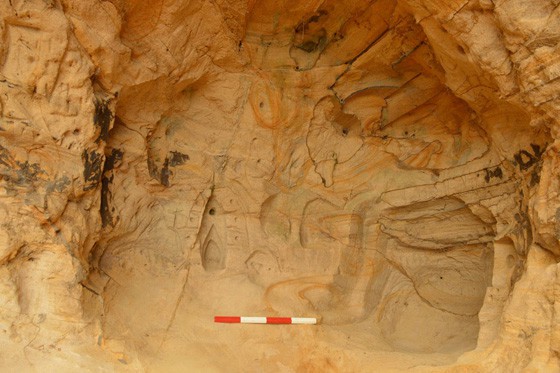A Surprise at St Catherine’s

If any of you have joined us on one of our walks along the North Downs Way heading out of Guildford along the banks of the River Wey, there is a good chance that we will have included a short diversion up to St Catherine’s Chapel. This is not only a super viewpoint across the area but is also a historically interesting structure. It has become even more interesting recently following a landslip which disrupted the adjacent railway line.
St Catherine’s Chapel, on top of the hill, was built in the early 14th century in the reign of Edward I. An annual fair, also dating from the Middle Ages, was held every year until after the First World War. But over the years evidence has been discovered of more distant human activity on the hill in the Iron Age, Bronze Age and even Mesolithic (middle Stone Age) periods.
An incredible hidden cave thought to have been used as a medieval shrine has now been discovered in the hillside by rail workers repairing a recent landslip. Network Rail engineers came across the small cave, with markings and evidence of use in the 14th century, while stabilising the embankment between the railway line and the A3100 Old Portsmouth Road.
The sandstone cave is made up of several sections ranging from 0.3 metres to about 0.7 metres high and it’s thought to be the surviving section of a much bigger cave. The rest may have been lost when the railway line was carved out of the hillside in the early 1840s.
Images taken from the site show the presence of a Gothic niche decorated in dots with a Calvary cross nearby. There are seven or eight further niches and experts found considerable evidence of writing and other markings across the cave ceiling.
The cave is partially covered in deposits of black dust, believed to be soot from lamps. The remains of two suspected fire pits were also uncovered in the cave floor. The hope is that radiocarbon dating can be used to establish the period when the cave was in use.
Mark Killick, Network Rail Wessex route director, said: “This is an unexpected and fascinating discovery that helps to visualise and understand the rich history of the area. A full and detailed record of the cave has been made and every effort will be made to preserve elements where possible during the regrading of the delicate and vulnerable sandstone cutting.”
Tony Howe, historic environment planning manager and county archaeologist at Surrey County Council, added: “The discovery of this cavern is tremendously exciting. It’s very early in the process of understanding its full significance, but the potential for knowledge acquisition is huge. We’re looking forward to learning an awful lot more about the site as studies progress.”



